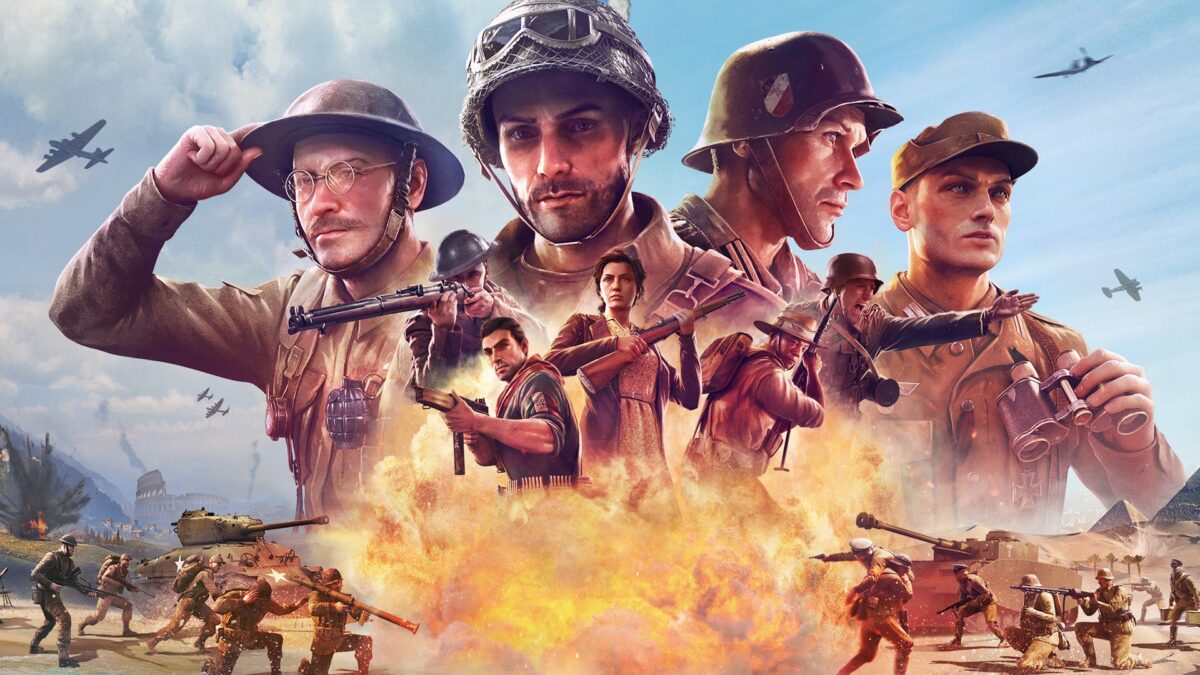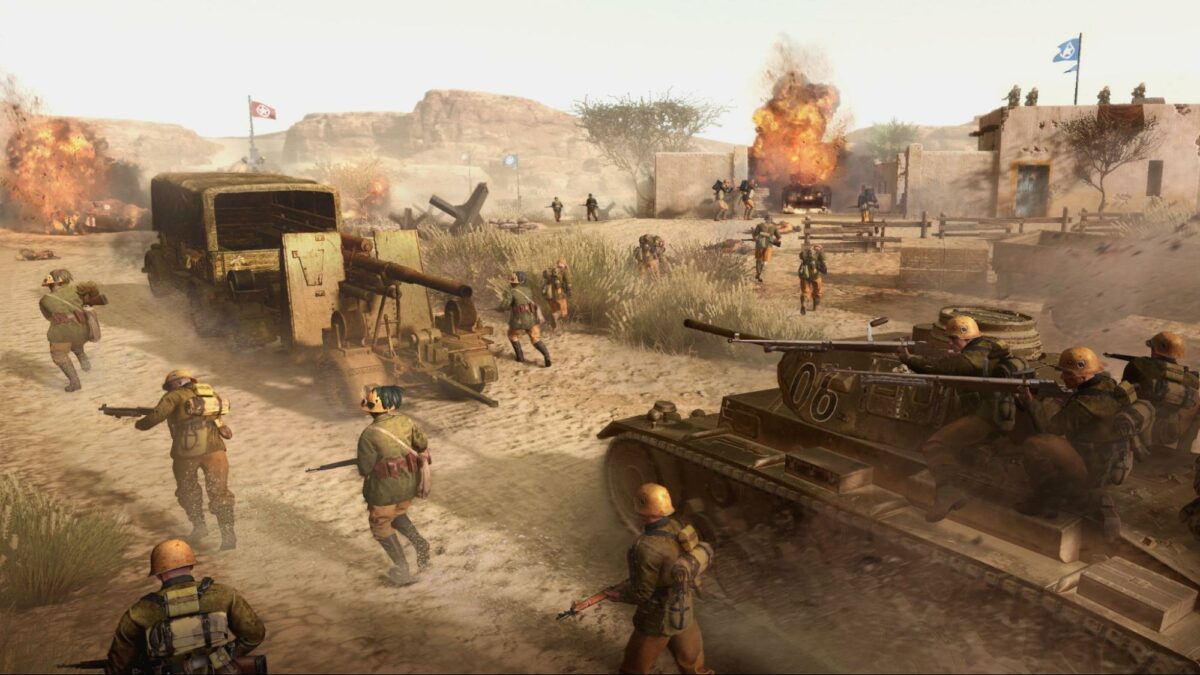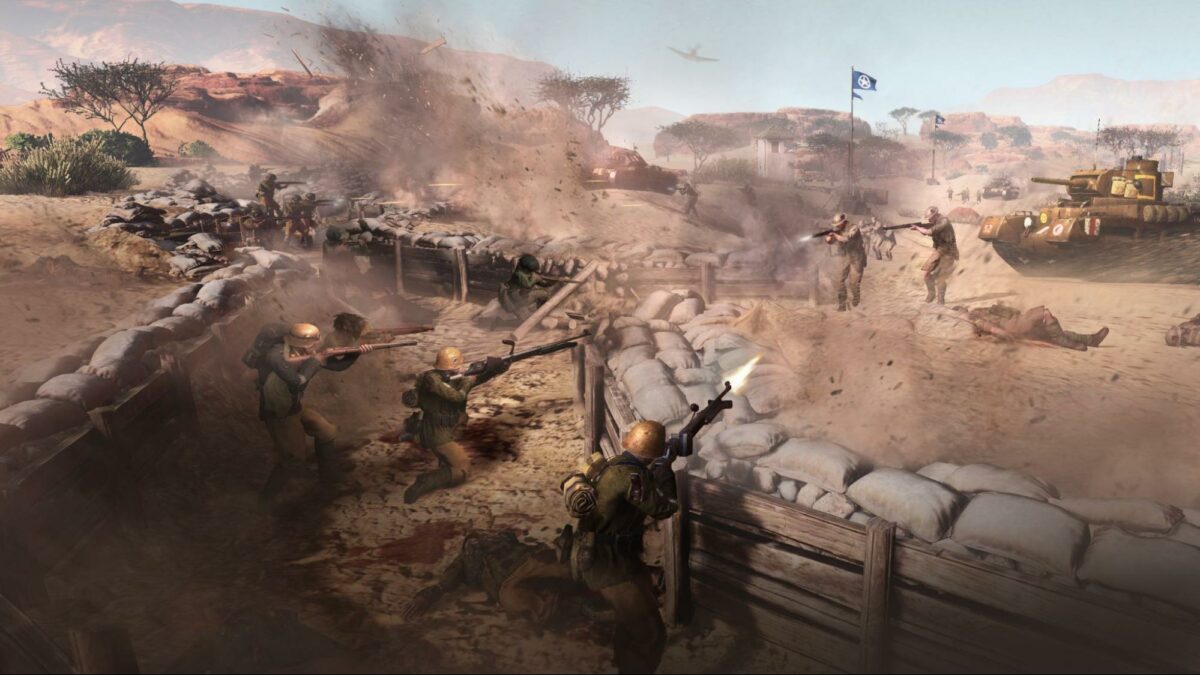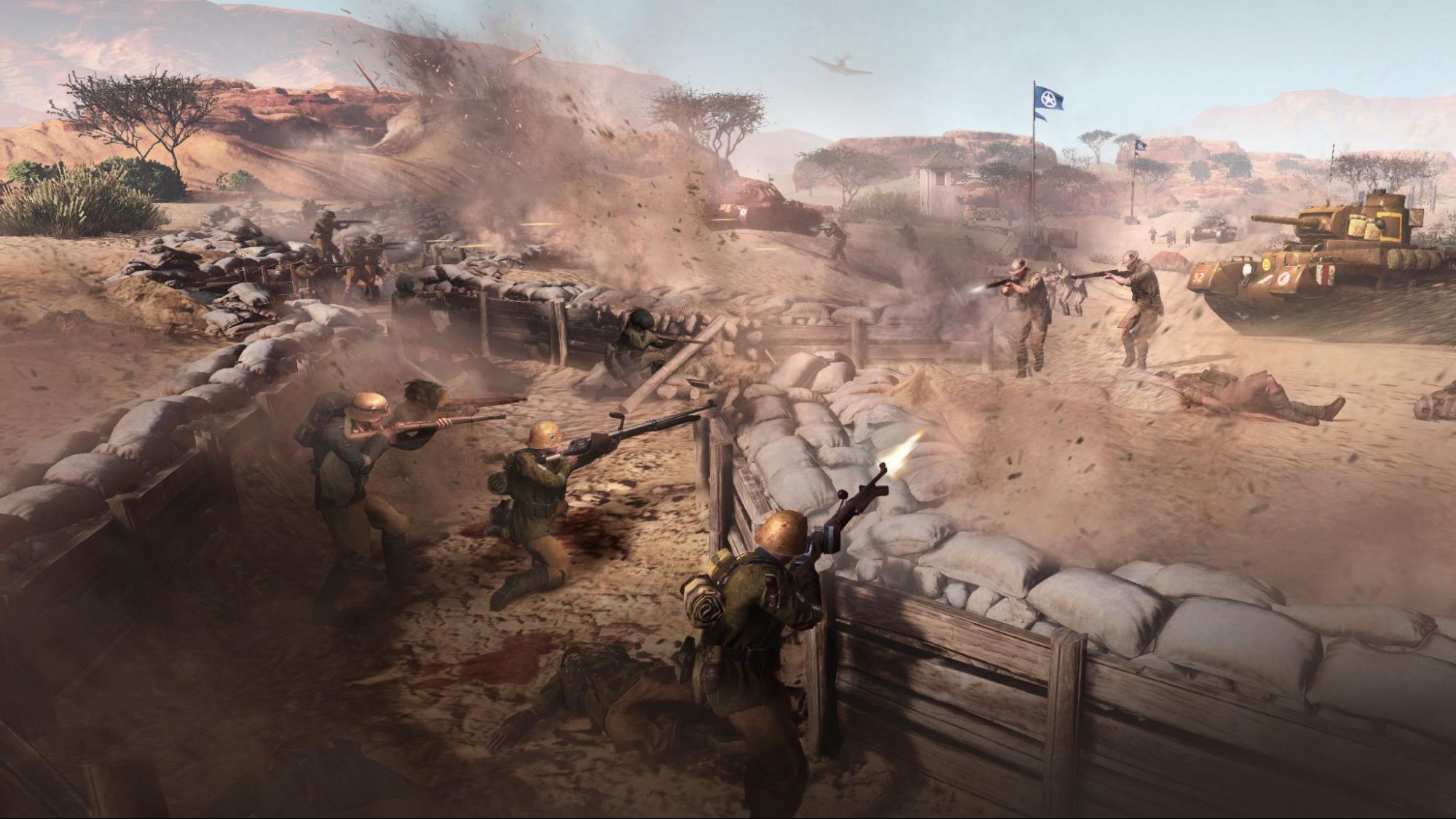Company of Heroes 3 has huge army boots to fill when it launches on Nov. 17, 2022, balancing new settings, factions, and gameplay features for a more modern time with the desires and expectations of an ardent, established fanbase.
Of the once numerous real-time strategy giants, three brands remain today that enjoy healthy player numbers. Two of them, StarCraft and Age of Empires, follow similar design principles – they feature an active economic system as well as deep base-building mechanics, and the macro element plays an important role. The other surviving brand of this golden era is called Company of Heroes (CoH) and follows a different recipe, in which the macro element is much less emphasized, while base building and the economy are simplified.
[mm-video type=video id=01g7sadm5qtrya5txzb7 playlist_id=none player_id=none image=https://images2.minutemediacdn.com/image/upload/video/thumbnail/mmplus/01g7sadm5qtrya5txzb7/01g7sadm5qtrya5txzb7-d50ec338a7881dac1ee441092a0a9c4f.jpg]
CoH aims to put its users right in the middle of the action and keep players’ attention focused on their units and the spectacle of battle. Together with the familiar setting of World War II, which is closer and perhaps more relatable to the audience than those of its competitors, the series thus provides a certain groundedness and intimacy. The bond between players and their units is a priority – the troops should not be impersonal entities to you that can be thrown away in battle, but valuable comrades you ideally stick with throughout an entire match.

These are principles that Company of Heroes 3 hopes to carry forward when it comes out on PC later this year. “Squad preservation is a huge part of our game. That’s part of the reason why we have the retreat mechanic,” Lead Gameplay Designer Matt Philip tells GLHF.
If a squad is badly battered, you can send it back to the nearest medical post at running speed with the click of a hotkey, where it can be revitalized with reinforcements. This is crucial because units accumulate experience points as they do battle over the course of the game, unlocking veterancy levels.
“Veterancy plays an important role in our game as a whole and our faction design,” Philip explains “We’ll have a mixture of active and passive abilities and units will be enhanced with different capabilities. The intent is that we are going to strive towards each faction having a unique veterancy system to add that layer of asymmetry.”. To strengthen the connection between players and troops, you’ll even be allowed to name your individual units in CoH3. Be ready to conquer the Mediterranean with mighty Tanky McTankface. Or, you know, Panzerchen von Panzergesicht, if you want to play as the Germans.
Four different factions will be playable at launch – doubling the previous two games’ starting armies. While this makes Philip and the team proud, “it’s also tougher to establish four factions that all feel unique and distinct and asymmetrical right out of the gate, as opposed to the previous games where we did two, which would typically be kind of a traditional experience. And then the next phase [i.e., in the expansions] would be to dive into making the factions radical. Trying to find that balance right out of the gate has been a very interesting journey.”
This time around, the US Army and the British represent the Allies and, along with the Wehrmacht as the first Axis faction, have already been introduced last year. The newly unveiled final addition to the lineup is an army that fans have wanted to see for years: the German Afrika Korps (DAK).

When Philip talks about radical design, it definitely applies here. The DAK is acutely mobile and highly mechanized, which should encourage an aggressive play style – I make a comparison with the Zerg from StarCraft that meets Philip’s approval. At the same time, the developers don’t want to restrict the players’ freedom too much and impose a certain style on them. Although the DAK is designed from the ground up for aggression, it has the necessary tools to act defensively, as Philip emphasizes: “We want that for all our factions. Especially from a multiplayer perspective, they should all be viable to be played offensively within a certain range. We call that ‘ebb-and-flow’.” That means that each faction has unique timings in the game when they are at their strongest and weakest in certain areas. “If someone comes from StarCraft and prefers that hyper-aggressive play style, they should be able to do that with any of our factions to a certain degree.”
The DAK, consisting of German and Italian units, draws on a number of features newly introduced to the series with CoH3 that make this mobile play style possible in the first place: Infantry are now allowed to mount tanks for quicker transport and heavy guns like the Germans’ dreaded 88mm anti-tank guns can be towed by trucks for rapid repositioning. Trenches can now be more easily overcome by tanks. This allows the DAK forces to make lightning-quick combined-arms advances at different points on the map – a fun as well as authentic implementation of the actual way of fighting the DAK was famed for under its infamous commander Erwin Rommel.

Thus, heavy guns no longer just sit around in one place for an entire game, but take part in ever more fluid battles. This means that players now have to pay more attention to their support units – if your trucks are destroyed, your valuable field artillery can be stranded in a precarious position. That’s where the DAK’s recovery trucks come in, which can restore and repair wrecked vehicles. It helps that even regular infantry like the DAK’s Panzergrenadiere now have a repair ability – albeit one that is far less effective than that of specialized pioneers.
These features not only allow for fresh gameplay for the series, but are necessary to deal with the realities of the North African setting, as Senior Mission Designer David Milne explains: “These are very unique spaces that blend both these wide open plains, where you can have some pretty big tank battles in, with rock formations, plateaus, coastal towns, and these massive defensive works and trenches they dug back then, to still provide opportunities to focus the action on battles between infantry.” Mobility mechanics such as tank-riding and towing help to bridge some of these areas and actually make these environments work in the game. Philip adds: “This theater is challenging, because the soul of CoH is the tactical infantry combat – that’s the bread and butter of the series. That requires a directional cover system and buildings. Once you get into the tank side of things, it puts pressure on all that space.”

It was very challenging to provide all the factions with a toolbox that allows them to go toe-to-toe with each other on all the maps, while remaining historically authentic, because of the natural differences between the two settings of North Africa and Italy, and the time difference of the campaigns – 1940 to 1943 for Africa versus 1943 to 1945 for Italy – Philip explains. He goes on to say: “If the British have an early-war Crusader and the Axis have a later-war Panzer IV, how do we compensate for that and shape this experience? There’s been some good discussion on how we should proceed and work with all these different tools and tactics from different times and stages, and how these four factions fit together to create – what we call – an ecosystem.”
When I ask the dreaded question of how RNG (i.e., random effects) would fit into this ecosystem, Philip just laughs and jokingly threatens to quit the interview. “I’m joking. We have to acknowledge that humanizing the battlefield is part of the soul, part of the legacy of Company of Heroes. It’s what separates our RTS from other games. I like to always refer to Company of Heroes as being organic. If you take two squads and have them shooting at each other, they actually miss. We want you focusing, looking at that presentation layer, and want it to feel alive and natural and organic. That’s what war truly was like – they missed,” Philip says. At the same time, he explains that the team is aware that this aspect has an enormous impact on balance and player frustration, and has been working closely with the community to identify and remove the RNG elements that are particularly frustrating without damaging the core experience.
Philip provides an example of this: “In CoH2 we have planes that circle around and we have anti-air vehicles. We used to have it so that when planes got shot down, they would crash somewhere on the battlefield. If it crashed on a squad or a tank, they took damage. There was a thought that this is, well, what would happen and it feels a little jarring if a plane crashes on your units and nothing happens to them. But this is where gameplay must trump that. We realized that was just frustrating for players and so we cycled that out. There are a lot more examples of that in the game.”

CoH3 also follows a practice that StarCraft 2 already made use of: Armies as you experience them during the campaign don’t necessarily match up with how they function in multiplayer. This allows the team much more freedom to adjust the mechanics and balance for each mode. Nevertheless, the developers have a difficult task ahead of them, because as David Milne explains, they want to balance the game for all multiplayer configurations – from competitive 1v1 to the delightful chaos of 4v4 games. The duo didn’t want to comment on other multiplayer modes yet aside from the usual offerings – so there might still be a surprise in store in that regard. Data from CoH2 has shown the developers that the majority of players initially start with the 2v2 mode, but later move on to 4v4 – a stat that well illustrates why many modern RTS games focus more and more on team-based gameplay.
Many aspects of CoH3 are based on collaboration between the developers and the community – a process Relic calls CoH-Development. In-depth user surveys and a council of respected community members help the teams to stay close to the expectations of their own fanbase. For example, Matt Philip reveals that the first public tests in 2021 provided his team with valuable feedback on the design of the Wehrmacht faction. Among other things, a more diverse arsenal of defensive structures, such as observation and command bunkers, has been added as a result.

Relic is very open to listen to the needs and desires of the established community. For example, there are currently no plans to allow mixed Allied-Axis teams in automatic matchmaking for CoH3 (this will still be possible in custom games, just like in CoH2), but if there is enough demand among users, a specific playlist for this is on the table. “We need to maintain flexibility here,” Philip notes. “It’s been a while since a CoH game came out, so I’m sure our audience has changed over time.”
The community-driven development process of Company of Heroes 3 is an encouraging sign for the game’s release and the support afterwards – it also doesn’t seem to lead to stagnation at all, which might have been a danger with entrenched community figures giving input. Instead, it drives some of the gameplay evolution that the third main game of the iconic series contains without losing its heart and soul. The harmony between the developers and their loyal community is perfectly balanced so far, and it shows in the game as the best ideas of both groups are considered and implemented. If Matt Philip, David Milne, and their colleagues can continue on this course with success, then Company of Heroes 3 may not only fill the shoes of its illustrious predecessors and make the existing audience happy, but even redefine them and bring in some fresh blood.
We also had an in-depth look at North Africa and the Company of Heroes 3 single-player campaign set there.
Written by Marco Wutz on behalf of GLHF.
[listicle id=1331177]
















